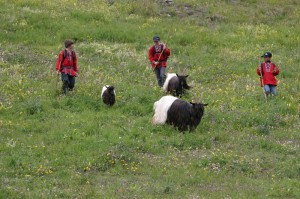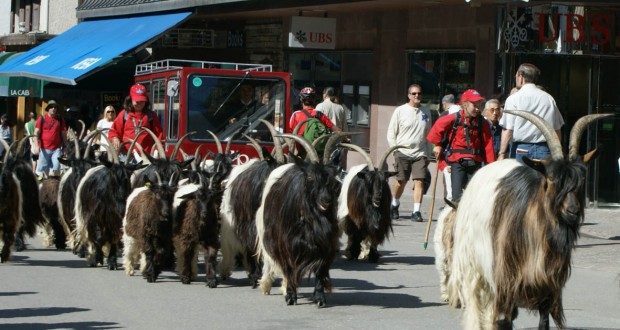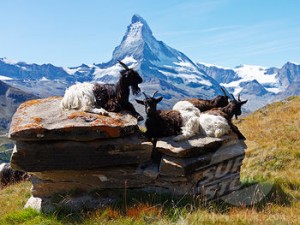Strolling down Zermatt, you might catch a unique view of goats walking. Goats hold a magical attraction for humans. This is particularly true for the blackneck goats which take their morning and evening stroll along Zermatt’s Bahnhofstrasse every summer. These goats are the most photographed goats in the world!
While some consider goats to be magical creatures, others may view them in a more demonic light. No wonder, since the devil is often depicted with goat-like features in the history of art and sculpture – replete with hooves, goat legs and horns. Humans find their unearthly rectangular pupils particularly disconcerting. In actual fact, however, goats are rather simple creatures, albeit unusual ones. Goats have a very unique character and they are clever, curious, fussy about their food and actually very stubborn. Blackneck goats are more archaic than dairy goats such as the Saanen goat. The latter are more amenable and affectionate whereas blackneck goats tend to be more reclusive, similar to chamois or ibexes.
The blackneck goats are driven through Zermatt by three children around the ages of 12. The young goatherds, among them mostly also girls, take turns on a weekly basis. They drive the goats along Zermatt‘s Bahnhofstrasse and up to the mountain pasture above the Spiss district, not far from the heliport. It’s challenging work for the young goatherds who have to be constantly on the alert. Goats are quick-footed when they are in search of that special delicious herb – they are, after all, gourmets. They love lustrous flowers, succulent herbs and bright-green grass. They take no notice of the dry and tough grass stalks as they wander across the meadow looking for their favorite tasty plants.
In the 1970s, the blackneck goat was close to extinction. Today, there are around 2,700 of these alpine goats living in the mountains, with 2,300 in the Upper Valais region. Strict criteria and clear definitions apply in the determination of a genuine specimen: The head, front legs and half of the body should be jet black while the hind legs should be snow-white. There must be a distinct border between the black and the white areas. The front cloven should be black and the back cloven white. The hair should be long and hang down below the underbelly. The white part may not contain any black hairs and vice versa. Their bodies have a characteristic shape dominated by a dipping pelvis and a straight back. Both males and females have horns. Billy goats reach a height at withers of up to 85 cm and weigh up to 90 kg, while female goats measure around 75 cm and weigh approximately. 60 kg.

Depending on their age, the goats produce up to 2 liters of milk a day. The blackneck goat, which is also referred to as the glacier goat, Sattel goat, Vispertal goat or Halsene, is one of the oldest domesticated goat species in the world.
The Goat’s Tour in Zermatt occur around the end of June until mid-August proceeding from Zen Stacken to Bahnhofplatz. They walk around 9 am in the morning and around 5 pm in the evening returning though the village to their Gadi or goat pen in Zermatt dialect.


